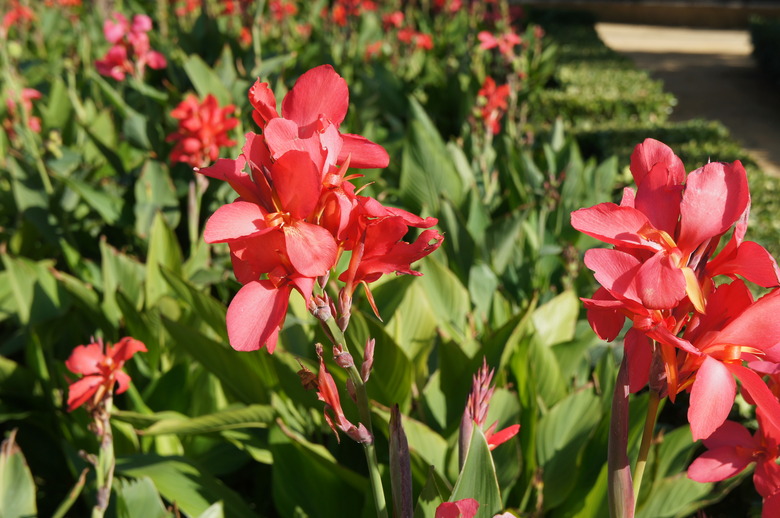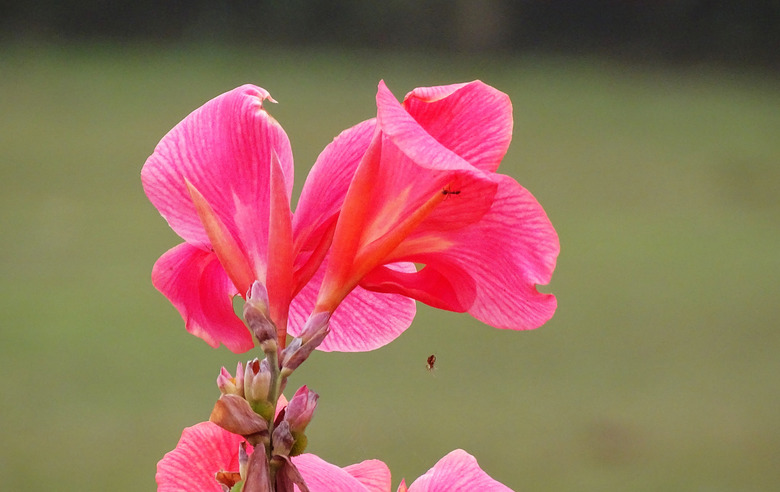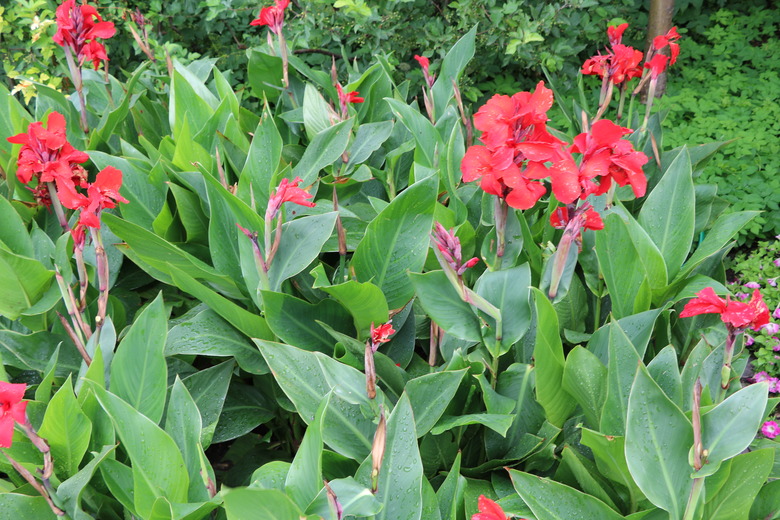How To Grow Cannas
We may receive a commission on purchases made from links.
If fortune truly favors the bold, the perennial canna (Canna indica) flower should have no trouble finding it in your garden. These super-bright plants feature large, unapologetic leaves in solid green, bronze, or variegated shades. A canna's leaves alone are enough to make the plant memorable, but cannas go even further, producing flowers in magnificent shades of red, orange, yellow and pink. Cannas keep producing these flowers all summer long, putting on a show from spring until frost.
Tall and stately, cannas can grow up to 8 feet tall. Dwarf varieties stay smaller, however, and grow only to 3 or 4 feet high. Clumps can spread to a width of about 6 feet, but most individual plants stay quite upright and remain a narrow 1 1/2 feet wide.
Best Uses for Cannas
Best Uses for Cannas
Given their tall stature and upright growth habit, cannas are excellent when you want a tall border or have a narrow planting bed to fill. Although some varieties are North American natives, the plants have a tropical look and feel that also works well next to swimming pools. Because they'll tolerate some boggy soil, you can also plant cannas around your backyard pond. They won't tolerate salt spray, however, so choose another species if planting along the coast or at your beach house.
Some gardeners plant cannas in large containers or pots, using them to create a center focal point. Cannas look good with colorful annuals but also work well with grasses and other plants that offer height but not color. Use them to make a colorful statement or sprinkle them throughout the garden where you want an unexpected pop of eye-catching color.
How to Grow Cannas
How to Grow Cannas
- Common Name: Canna, canna lily
- Botanical Name: Canna indica
- When to Plant: Wait until night soil temperatures are above 60 degrees Fahrenheit
- USDA Zones: 8-11
- Sun Exposure: Full sun
- Soil Type: Loamy
- When it's in Trouble: Weak stems, yellow streaks or spots on leaves
- When it's Thriving: Large, upright leaves and bright flower
Starting Cannas From a Rhizome
Starting cannas from seed is a nearly impossible task. The seeds have a very low germination rate coupled with an extremely tough outer shell. Gardeners need to break through this shell by filing it away or giving the seeds an acid bath. It's much easier and safer to start cannas from rhizomes, which are modified stems that spread just under or at the soil surface.
Although many gardeners and garden centers refer to them as bulbs, the pieces of canna that you plant are actually sections of a rhizome. Ideally, the rhizome you acquire will be several inches long and contain three to five eyes.
Begin your planting by spreading a 4-inch layer of compost on your planting bed. Work the compost into the soil, loosening it to a depth of 12 to 15 inches. Dig a planting hole about 3 inches deep and place your rhizome in it with the eyes facing up. Don't worry if some of the eyes on your rhizome face up but others face down. The sprouts that grow from the downward-facing eyes will find their way as the plant grows.
Space your rhizomes about 4 feet apart when planting them. Backfill the planting holes, tamp the soil over the rhizomes firmly and water your new plantings. Unless your soil is very dry due to drought conditions, don't water your young cannas again until you see sprouts poking through the soil. At this time, soak the soil around the plants once a week.
In What Zone Do Cannas Grow Best?
In What Zone Do Cannas Grow Best?
You can grow cannas as perennials in USDA hardiness zones 7 through 11. In some areas across zone 7, canna plants may or may not survive the winter outdoors depending on how cold the season happens to be. To play it safe, gardeners in zone 7 should winterize their canna plants or dig them up after the first fall frost and take the rhizomes indoors for safekeeping until spring. This will save you from having to buy new plants every year.
When Should You Plant Cannas?
When Should You Plant Cannas?
Plant your cannas in the spring when the soil temperature stays 60 degrees Fahrenheit or above all night. If you want to enjoy your cannas for as long as you possibly can, start them indoors a few weeks before the last frost to give them a head start. It's time to plant your cannas outside around the same time that you plant your tomato plants.
Soil, Sunlight and Water Recommendations for Cannas
Soil, Sunlight and Water Recommendations for Cannas
Cannas enjoy a soil pH between 6.0 and 6.5. If your soil is more acidic than this, it's best to amend it with some lime before planting. Loamy soil is best, but cannas will tolerate moist soil. Place your plants where they will get at least four hours of direct sunlight every day and where they will have shelter from the wind. The large leaves of canna plants catch gusts easily and may blow over during heavy winds if they're not sheltered.
Most cannas support their own weight without issue, but stake top-heavy plants if needed to keep them upright. Give your cannas about an inch of water per week if Mother Nature doesn't. Mulching around your cannas will help preserve water and keep weeds down.
Cannas like about an inch of water per week during the growing season and do enjoy a fertilizer treatment in early spring with a 5-10-5 fertilizer. If desired, fertilize twice more throughout the growing season. If you have it on hand, fish emulsion, tomato or rose fertilizers also work well with cannas. These fertilizers are higher in nitrogen, however, and will encourage your cannas to grow a bit taller. As your canna flowers fade throughout the season, deadhead them to encourage new blossoms.
How to Propagate Cannas
How to Propagate Cannas
You can divide your canna plant if you wish to grow more. You'll need to divide your cannas in the spring, however, so plan ahead. In the fall, dig up your canna rhizomes and store them over the winter in a cool, dry place like your garage or basement.
In the spring, cut the rhizome into new sections before planting. Each new rhizome should contain three to five eyes, or growing buds. The more eyes there are on the rhizome, the more leaves and flowers the new plant will grow. After cutting your rhizomes apart, let them sit for a few days before planting to give the fresh cuts time to dry and heal. For best results, divide your canna plants only once every three or four years.
How to Winterize Cannas
How to Winterize Cannas
In hardiness zone 8 and warmer, your cannas can stay in the ground and safely overwinter. Simply cut the plant stems down to 4 inches in late autumn, and the plant will do the rest. If you live in zone 7, however, it is possible that the winter could get cold enough to kill off your cannas. Here you have two options for overwintering the plant.
One is to leave the rhizomes in the ground but add some extra insulation just in case the temperatures dip below freezing. Cut the plant stems back as you normally would but then cover the plant and the area around it with about 4 to 6 inches of mulch. This extra insulation will hopefully protect the plant from a cold snap.
If your area is expecting a colder winter than normal, dig up your cannas and take them indoors to keep them safe until spring, Cut back the plant to a height of 2 to 3 inches. Using a trowel, loosen the soil about a foot away from the cut stems. When it's loose, gently use your fingers to dig closer to the canna rhizome and lift it from the ground without damaging it.
Shake the dirt off the rhizomes and cut off the remaining foliage. Set the rhizomes in the garage or basement for a few days so it can dry completely. Wrap the dry rhizome in newspaper with a bit of dry peat moss and store it in a dry place where the temperature won't dip below 40 degrees. Store each rhizome separately.
If necessary, you can sprinkle some water over your canna rhizomes a few times over the winter but do so only if they are bone dry. Too much water will cause the rhizomes to rot. Water them very sparingly and when in doubt, leave them dry. The goal is to prevent the rhizomes from shriveling without encouraging rot.
Common Pests and Other Problems for Cannas
Common Pests and Other Problems for Cannas
Caterpillars, slugs and snails all visit cannas from time to time. They're typically not a big issue, but they can chew noticeable holes in your canna's large leaves. If you notice these insects, pick them off your plants by hand or spray your plants with Bacillus thuringiensis. This is a naturally occurring soil bacterium that kills many insects. Aside from these common garden visitors, your cannas shouldn't attract any unwanted attention. They may even attract a few hummingbirds.
Common Diseases for Cannas
Common Diseases for Cannas
Rust, fungal leaf spot and bacterial blight can affect cannas. You can usually prevent these diseases with proper plant spacing to improve air circulation and good gardening practices. Regularly rake up dead plants, fallen leaves and debris around your plants, keep weeds to a minimum and stay out of the garden when it's wet. When irrigating plants, direct the water at the ground and try to avoid wetting plant foliage.
Several fungicides and plant treatments can help with these issues, and there is value in trying them if you catch infections early. If it feels as though you're losing the battle, however, remove and destroy affected plants before they contaminate others.
References
- Gardenia: Learn How to Plant, Care and Grow Splendid Canna Lilies
- American Meadows: How to Grow Cannas
- The Old Farmer's Almanac: How to Plant, Grow, and Care for Canna Flowers
- The Old Farmer's Almanac: Rust Plant Disease
- Missouri Botanical Garden: Canna (group)
- Missouri Botanical Garden: Fungal Spots, Blights, and Blotches


